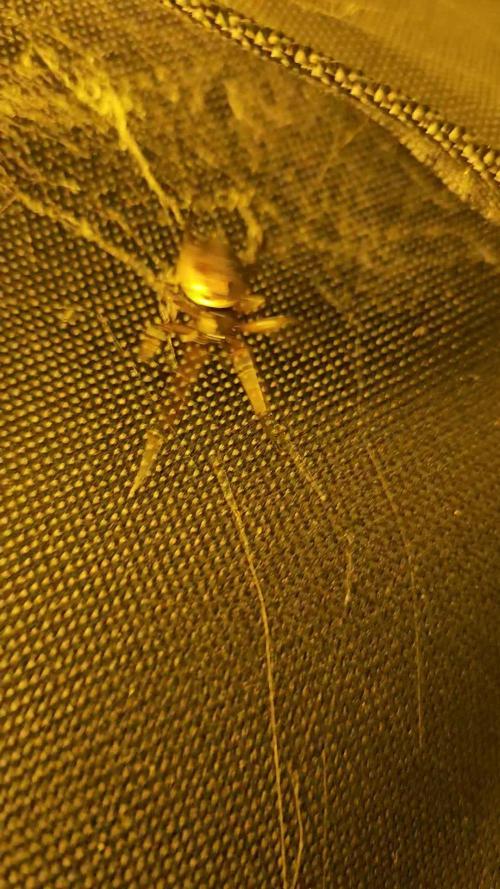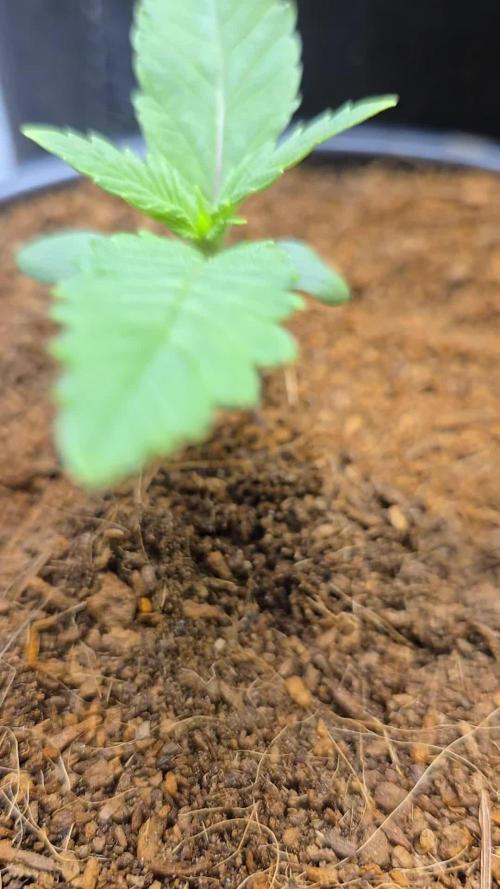By continuing to use the website or clicking Accept you consent to our cookies and personal data policy and confirm that you are at least 18 year old. For details please see Privacy Policy and Terms
Accept
Likes
Comments
Share


@UnorthadoxDude
Follow
Week three of flower is here and the pistils are popping out all over the place now.
The final tuck was done on day 14, two days ago. From here I am just letting them grow out, the second net is just to support the colas as they develop and pack on weight.
Day 16 of flower: Photographed and took a video.
Day 18 fertigated 2.5l each and video
More updates to come later in the week.
If you are on X, please follow me @Unorthadoxdude
Processing
Likes
30
Share


@Velk1
Follow
Videos are uploading finally 👌🏾 baby's have been switched to bloom nutes ,and moved from the nursery to the main room
I decided to build a scrog to help keep the power of the mbap's under control 🌱🌿🌲🌳 was a very easy and cheap build really happy with the quality.
Grapewalker kush are booming the one that sprouted already topped I decided to go with main lined kind of training it's gone to a lovely shape , may even put in the scrog who knows
The gold glue all I'm gonna say is the topping went down a treat , it has formed really thick stems and branches and seems to be quite tall hopefully this and training will unleash the beast
Likes
10
Share


@RandomStreetMerchant
Follow
This was a busy week for the girls, they got trimmed up and bent around to maximize their space and growing potential.
Thinking we will be vegging for a while with this one.
Going to try and get a monster plant with these girls.
When you touch them they leave a gas smell on the fingers already 🤯💀
The twisted sister has made a full recovery and I think that she will have super deep purple coloring because some of the leaves have like a purple hue to them.
Until next time growmies, best of luck ✌️ 07/03/23
Likes
1
Share


@Pierrougarou21
Follow
Ne domez pas la strcture des fleurs commencent a eclater c est jolie a regarder
Likes
42
Share


@KrautFabrik
Follow
Day 60: flushed 💦
Pictures are taken on day 62
---------------------------------------------
Super frosty buds, she is getting fatter 😁❄️
Happy growing 🦍🌱
Processing
Likes
12
Share


@w33dhawk
Follow
So Woche 6is angelaufen und ich entschuldige mich schon mal in Woche 5 nichts an Bildern hochgeladen zu haben.
Hab jetzt die 2 hinteren Sapphire scout zum 2ten mal getoppt die vordere davon nur 1x bei den rqs zz is bis jetzt nur die hintere 1x getoppt und die beiden vorderen noch garnicht hoffe die beiden kann ich wenigstens einmal toppen die machen mir echt Sorgen vorallem die am Anfang stehende zz is recht krüppelig ich denke mal das die wurzeln nicht richtig durch die jiffies kommen (netzt nicht AUFGELÖST) würde in Zukunft die scheiss Dinger weg lassen und mir kleine durchsichtige getränkeflaschen zerschneiden um daraus anzuchtopfe zu machen dann fällt das netz weg und es gibt wohl weniger Sorgen nächste Woche lass ich mein scrog netzt drauf um das ganze zu begrenzen und hoffe das dann die rqs samen noch aufholen können
Likes
31
Share


@valiotoro
Follow
Beautiful buds super sticky✂️
Delicious smell something new to me!
Cant Wait the curing to taste this beauty
Likes
20
Share


@apmcfly76
Follow
She’s a big one cannot wait to see what she put out. she got unhappy and lost most of the fan leaf but she still going.
Likes
33
Share


@TeknoRanger
Follow
🌱 Sour Apple⠀⠀⠀
🌸 flowering 9 weeks⠀⠀⠀⠀⠀⠀
💚 70% Indica, 30% Sativa⠀⠀⠀⠀⠀
💣up to 27% THC⠀⠀⠀⠀
👅Apple, lemon⠀⠀⠀
⚖️ 550g/m²⠀
Sour Apple was created by an intersection of the original Sour Diesel and a Pure Kush. It is an indica dominant hybrid with a combination of both indica and sativa effects. It has an delicious intense taste of sour apples and lemon and a gigantic potency.
The rockhard buds are covered in a thick layer of milky white trichomes and are packed with sweet resin. Users describe the high of the sour Apple as a strong mental shift, a uplifting head high that leaves you motivated and focused with a sense of overwhelming euphoria and social tendencies. This is followed by a slow fade into an intensely overwhelming couch-lock. Sour Apple sends her 27% of THC stright to your mind to kick you in other psychedelic spheres. We proudly present this unique goddess to all the growers in the world.
GROWING SOUR APPLE
When growing indoors it is a good idea using screen of green or sea of green methods. You can expect big yields of 500g or more per squae meter indoors, 700g per plant outdoors. The flowering time is 9-11 weeks. Indoors, Sour Apple is a vigorous grower with many side stems which can be trimmed to keep the plant in bounds. Indoors, the plants grow between 1,00-1,50 m depending on the introduction of the flowering phase, outdoors Sour Apple can reach four metres of hight.
MEDICAL USE
Because of its strong effects Sour Apple is an ideal strain for treating patients who suffer from conditions such as chronic stress or anxiety, chronic pain due to injury or illness, and sleep disorders (insomnia and sleep apnea). In low doses it is daytime suitable for medical applications, at higher doses, it is the ideal weed for medication at the evening.
Likes
9
Share


@Headies
Follow
So I had a few issue. I over watered early on, took them out the seed tray early, started feeding them a week or two late, no humidifier yet but they recovered well.
Likes
Comments
Share


@Elguacho420
Follow
Buenas a tod@s... Otra semanita de floración para estas hermosas.... Han crecido bastante, las veo muy bien, riengo generalmente cada 2 días, el pH perfecto, absorben muy bien los nutrientes, el sustrato muy bien desde q lo eh cambiado este cultivo... Esty muy contento y el resultado va tomando forma, trabajando duro se obtienen buenos resultados a la larga, hay algunos fallos para mejorar pero de momento las niñas están bien y van creciendo y engordando favorablemente... Me gustaría tener más espacio y más material tecnológico para el cultivo, pero de momento es lo q hay y nos apañamos bien... Buenos humos para todos 🏻💨💨
😎💀
🇦🇷🤝🏻🇪🇦
Likes
4
Share


@Taima
Follow
Day 30
Starting to stretch. Seems to be liking nutes.
I have my sprinkler setup to water for 15 minutes every 24hrs. Also got my security setup.
I'm able to keep an eye on everything while I'm not home. Hopefully chronics leave my girls alone.... the 2 in the back just started flushing. Aloha.
Likes
8
Share


@Chubbs
Follow
420Fastbuds
FBT2312/Week8
What up what up grow fam. Weekly update on these two frosty girls. They both are maturing nicely at the flower sites. Starting to smell super pungent. Still keeping up the same routine for the next week or two before I'll start checking trichs.
All in all Happy Growing
Likes
16
Share


@Jays_Not_Here_Man
Follow
**Update** 96.5 grams dry from 1 Autoflower! Amazing smells, still has some of the 🍈 funk. She needs to cure to let the Terps and Flavors come out. She is still very sticky and resinous. Will update once a week or two of cure is done, but with the 1 joint I smoked, full heavy hitter, body buzz and heavy head high. Looking forward to the finished product.
This plant flourished with little work on my part. Good nutrients, and not being too hands on let this beast do her own thing. I would definitely recommend as a beginner strain/auto flower to go with, she is easy to see through to the end. Didn’t really need much attention until flower came on and she fed hard for phosphorus and potassium while she stacked. I’ve got some of her cousins already sprouted and am looking forward to trying some different techniques to see what she can do! Happy growing all 🌱😎
Likes
5
Share


@Naujas
Follow
Day 70!!!! Girl, she looks amazing, this week I removed some leaves to give her a lot of energy for the flowers:) the girl drinks every 2 days, next watering I will probably give her the last water with biobizz fertilizer, next week, I'm going on a short vacation (5 days) I will ask my friend to come and water her, but it will only be clean water 6.3ph:) probably when I get back, it will already be harvest week:).
Likes
11
Share


@MrGrowDiarie
Follow
Week 2 – Normal growth, just still small
She’s coming along nicely. Growth looks healthy and steady – nothing explosive yet, but that’s expected this early. Starting to push out her second set of true leaves. Color is good, leaves are perky. Everything looks on track so far, just early-stage growth. Let’s see how she takes off in the coming days





















